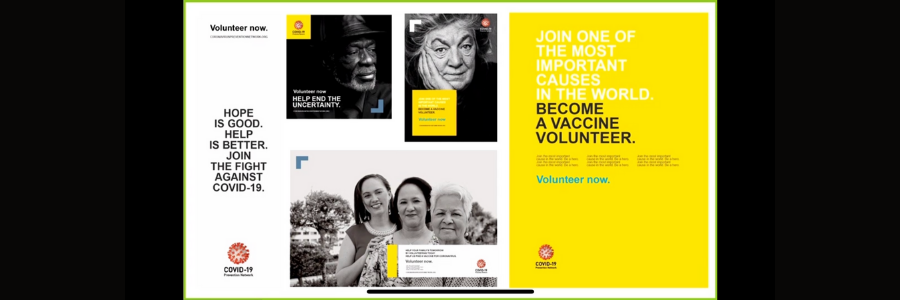COVID Symposium Highlights the Hard Work Behind the Headlines
Emily Walsh Martin, Ph.D. - September 16, 2020
The much discussed COVID-19 Prevention Network slogan, "Hope is good. Help is better." really sums up the important work being done by the presenters at the ASGCT COVID-19 Symposium.

It has been sometimes difficult over the past six months to distinguish real progress from hype in the news coverage of the global effort to fight the pandemic. What the two-day ASGCT COVID-19 Symposium offered was a peek behind the scenes to reveal the operational excellence underlying a number of meaningful efforts to fight COVID-19. In short, while the field is working fast, it is also working smart. And most importantly, in many cases, the field is working collaboratively. I encourage anyone who missed the two-day Symposium to register for free and peruse the recorded sessions at their leisure. As you do, I think you will be struck, as I was, with the strong sense that there is well-laid groundwork which provides a strong basis on which to hope for significant progress in the clinic.
Herein I’ll just cover a couple of those talks which spoke to me as a drug developer, but I encourage you to do your own diligence and find your ray of potential sunshine.
Larry Corey, M.D. – University of Washington
Corey began his talk by providing his view on the “reasons to believe” that the SARS-CoV-2 virus may lend itself to vaccine development in spite of failures for other viruses (notably HIV).
Briefly, key points that provide optimism are that humans “self-cure;” reinfection seems rare; SARS-CoV-2 virus mutates slowly and mutates rarely in the spike protein; viral latency is not observed; and infection with the virus inspires an active immune response.
Corey went on to describe theoretical concerns for the vaccine efforts, including vaccine-enhanced respiratory disease, and how the current Ph3 efforts are well-powered to detect such issues. Moreover, he highlighted in the Q&A that it is important to remember that the trials are powered to detect 50 percent protection against infection (with a lower bound of 30 percent), so a successful vaccine in the trial will have no worse than 30 percent efficacy.
Most importantly, Corey corrected the misconception that we are in a “race” for a (single) vaccine. Rather, he shared the perspective that all the vaccines which perform well will likely find a path to contribute meaningfully to U.S. vaccination efforts given the challenges of rapid manufacturing and distribution to 330 million individuals.
Myron Cohen, M.D. – UNC School of Medicine
Cohen shared the experience of the clinical operations complexity involved in human trials of novel therapeutics as part of the NIAID COVID-19 Prevention Network (CoVPN), which brings together 189 global trial sites. While companies that leverage the CoVPN network maintain sponsorship of their own trials, they benefit from the know-how and operational infrastructure (e.g. DSMB, etc) of the network.
He further described the design concepts of two types of trials being performed by the network to evaluate COVID monoclonal antibodies: household and congregate living facilities. Lastly, he shared the NIH Operation Warp Speed efforts to evaluate therapies. Herein, there are four groups (ACTIV-1, 2, 3, and 4) which focus on distinct clinical questions (anti-inflammatory effects, outpatient, inpatient, and anticoagulation effects, respectively). Each of these groups has a single, specialized, NIH-sponsored, Ph3 trial protocol so that therapeutic agents can be uniformly compared not just against placebo but also against each other at the end of the day.
Erica Ollmann Saphire, Ph.D. – La Jolla Institute of Immunology
Ollmann-Saphire described the efforts of the Coronavirus Immunotherapeutics Consortium (CoVIC) funded by the Gates Foundation, NIH and GHR foundation. For CoVIC, similar to the clinical efforts described by Cohen, the goal is to provide head-to-head comparison of monoclonal drug candidates, in this case via preclinical assessments.
Ollmann-Saphire started her presentation by sharing the valuable insights derived from a similar effort previously organized during the 2013 West African Ebola outbreak. She then shared how the CoVIC team will employ the general learnings from the Ebola effort to strategically identify the most predictive in vitro assays for in vivo therapeutic benefit. Importantly, she described how the effort is bringing together candidates from across academia and industry in “blinded” head-to-head comparisons.
Sponsors participating in CoVIC receive data for their candidate antibody compared to the anonymized field of candidates across a number of in vitro and in vivo assays which she indicated are statistically validated and often run by CROs. Further, the sponsors are able to use this data in publications, regulatory filings, or internal decision-making. And as clinical data is generated over time, the field can use that to guide decision-making around which assays were the most predictive of success for patients.
Lastly, exploration of antibody combinations which would not be possible outside of a collaboration of this sort is the one opportunity that this effort allows. So, if it turns out that mixtures of antibodies are more successful at preventing or reducing the severity of COVID-19, only collaborative efforts like CoVIC will afford us the opportunity for discovery.
Not surprisingly, many attendees asked the question “when” at the end of each talk, and I think that speakers responded thoughtfully about timelines. However, for me, the detailed discourse on the “how” of the ongoing work answered the most important question of all. The thoughtful diligence described by the speakers gives me greater hope that “when will progress occur?” is the appropriate question rather than “if.”
Dr. Walsh Martin is a principal at Tremont Therapeutics and a member of the ASGCT Communications Committee.
Related Articles